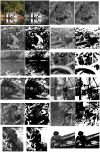Cultural differences in perceptual reorganization in US and Pirahã adults
- PMID: 25411970
- PMCID: PMC4238998
- DOI: 10.1371/journal.pone.0110225
Cultural differences in perceptual reorganization in US and Pirahã adults
Abstract
Visual illusions and other perceptual phenomena can be used as tools to uncover the otherwise hidden constructive processes that give rise to perception. Although many perceptual processes are assumed to be universal, variable susceptibility to certain illusions and perceptual effects across populations suggests a role for factors that vary culturally. One striking phenomenon is seen with two-tone images-photos reduced to two tones: black and white. Deficient recognition is observed in young children under conditions that trigger automatic recognition in adults. Here we show a similar lack of cue-triggered perceptual reorganization in the Pirahã, a hunter-gatherer tribe with limited exposure to modern visual media, suggesting such recognition is experience- and culture-specific.
Conflict of interest statement
Figures




Similar articles
-
The elusive illusion: Do children (Homo sapiens) and capuchin monkeys (Cebus apella) see the Solitaire illusion?J Exp Child Psychol. 2016 Feb;142:83-95. doi: 10.1016/j.jecp.2015.09.021. Epub 2015 Oct 26. J Exp Child Psychol. 2016. PMID: 26513327
-
Speech and non-speech audio-visual illusions: a developmental study.PLoS One. 2007 Aug 15;2(1):e742. doi: 10.1371/journal.pone.0000742. PLoS One. 2007. PMID: 17710142 Free PMC article.
-
Grasping visual illusions: consistent data and no dissociation.Cogn Neuropsychol. 2008 Oct-Dec;25(7-8):920-50. Cogn Neuropsychol. 2008. PMID: 19378412
-
Phantom perception: voluntary and involuntary nonretinal vision.Trends Cogn Sci. 2015 May;19(5):278-84. doi: 10.1016/j.tics.2015.03.004. Epub 2015 Apr 8. Trends Cogn Sci. 2015. PMID: 25863415 Review.
-
[Perception of physiological visual illusions by individuals with schizophrenia].Psychiatr Pol. 2015 Mar-Apr;49(2):325-36. doi: 10.12740/PP/27072. Psychiatr Pol. 2015. PMID: 26093596 Review. Polish.
Cited by
-
Perceptual reorganization from prior knowledge emerges late in childhood.iScience. 2024 Jan 4;27(2):108787. doi: 10.1016/j.isci.2024.108787. eCollection 2024 Feb 16. iScience. 2024. PMID: 38303715 Free PMC article.
-
Mooney face stimuli for visual perception research.PLoS One. 2018 Jul 6;13(7):e0200106. doi: 10.1371/journal.pone.0200106. eCollection 2018. PLoS One. 2018. PMID: 29979727 Free PMC article.
References
-
- Adelson EH (1993) Perceptual organization and the judgment of brightness. Science 262: 2042–2044. - PubMed
-
- Helmholtz Hv (1971) Selected writings of Hermann von Helmholtz; Kahl R, editor. Middletown, Conn.: Wesleyan University Press. 542 p.
-
- Spelke ES (1990) Principles of Object Perception. Cognitive Science 14: 29–56.
-
- Köhler W (1929) Gestalt psychology. New York: H. Liveright. 403 p.
MeSH terms
LinkOut - more resources
Full Text Sources
Other Literature Sources

